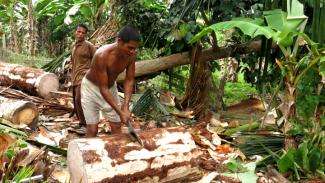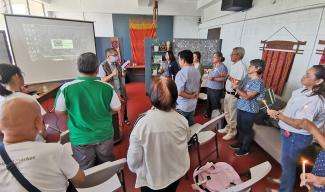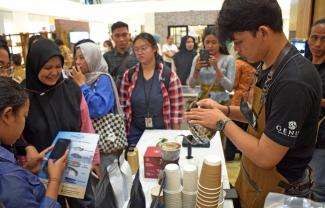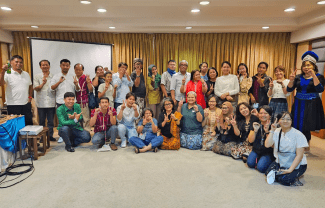The village of Sungai Tohor in the Meranti region is an area of sago production. Local residents say that this region produces the most sago in all of Indonesia. Sago is a type of food that is prepared from the sago palm tree. In addition to eating sago, other uses of the tree include using the waste as fodder, the trunk as firewood, and the leaves as roofing material for houses.
According to 42 year-old Abdul Manan, one of Sungai Tohor's community leaders, sago palms are native to Sungai Tohor and were already growing in 1904 when the village was established. Since the 1970s, sago cultivation has been done on a large-scale.
"Since 1970, the community began investing in sago production. Cultivation was done first in the area of Simpang Kanan within Sungai Tohor," explained Manan.
Initially, the community only cultivated sago for subsistence food. But with the increase in the economic value of sago, the community began developing other products. They developed refineries to produce wet sago. Today, of the 28 refineries in the district of Tebin Tinggi Timur, 12 are located in Sungai Tohor. Before these refineries were built, middlemen controlled the community's production. Once the community built its own refineries, they were able to break free from the middlemen's control.
Sungai Tohor's strength in sago production is evident in the large amount of wet sago it produces, which has reached 480 tons per month. The revenue from this production, now 864,000,000 Rupiah, is shared among 300 families in Sungai Tohor. The profits from sago have even financed several residents to go on Hajj to Mecca.
However, since 2011 production has been declining, said residents, because of a canalization project begun in 2009 by PT Lestari Unggul Makmur (LUM), a company that has a timber concession for an industrial plantation forest (HTI). The canal project has damage the ecosystem of the peatlands forest where the sago palm tree grows.
"Before PT LUM's canal project, Sungai Tohor's sago production was going to reach 600-700 tons," said Ridwan, a local sago producer.
Wet sago production in Sungai Tohor is actually developing enough potential to meet local as well as national needs. In fact, sago from Tungai Tohor is even becoming a commodity export to Malaysia and several other countries. Aware of this potential, the community is eager to introduce and popularize sago again to the wider community. It is positive initiative at the local, national, and international levels.
The authors participated in the Learning to Write Together workshop conducted by Samdhana and Wahli in Riau, Sumatra on 11 November 2013 at Sungai Tohor.




